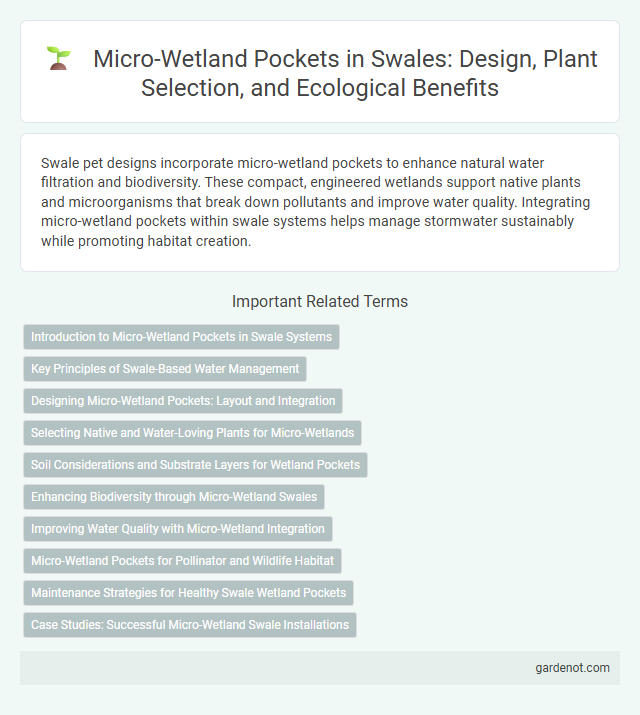Swale pet designs incorporate micro-wetland pockets to enhance natural water filtration and biodiversity. These compact, engineered wetlands support native plants and microorganisms that break down pollutants and improve water quality. Integrating micro-wetland pockets within swale systems helps manage stormwater sustainably while promoting habitat creation.
Introduction to Micro-Wetland Pockets in Swale Systems
Micro-wetland pockets in swale systems serve as compact, natural filtration zones that enhance water quality by trapping sediments and promoting nutrient uptake through diverse wetland vegetation. These microhabitats support biodiversity and regulate hydrological cycles by slowing runoff flow, facilitating infiltration, and providing habitat for aquatic and semi-aquatic species. Integrating micro-wetland pockets within swales significantly contributes to urban stormwater management and ecological resilience.
Key Principles of Swale-Based Water Management
Micro-wetland pockets within swale-based water management function by enhancing natural filtration, sediment capture, and biodiversity support. These systems utilize vegetation and soil media to slow stormwater flow, promoting infiltration and pollutant removal before runoff enters larger water bodies. Key principles include maximizing surface area for absorption, maintaining gentle gradients to reduce erosion, and integrating native plants to improve habitat value and water quality.
Designing Micro-Wetland Pockets: Layout and Integration
Designing micro-wetland pockets within swales requires careful consideration of hydrology, soil type, and native vegetation to optimize water filtration and habitat creation. Integrating these pockets involves creating shallow basins with gently sloped edges that encourage sediment deposition and support diverse wetland plant species. Proper layout enhances stormwater retention, improves nutrient cycling, and contributes to overall watershed health by mimicking natural wetland functions.
Selecting Native and Water-Loving Plants for Micro-Wetlands
Selecting native and water-loving plants for micro-wetlands enhances the swale's natural filtration and biodiversity. Species like Carex spp., Juncus effusus, and Salix spp. thrive in saturated soils, promoting nutrient uptake and erosion control. Integrating these plants supports local wildlife habitats while maintaining water quality and system resilience.
Soil Considerations and Substrate Layers for Wetland Pockets
Micro-wetland pockets within swales require carefully selected soil substrates that balance permeability and nutrient retention to support optimal plant growth and microbial activity. Layers typically include a foundational gravel or sand base to enhance drainage, an intermediate organic-rich soil layer to promote nutrient availability, and a top layer optimized for wetland vegetation rooting. Effective design of these substrate layers ensures sustained hydrological function and pollutant attenuation in micro-wetland systems.
Enhancing Biodiversity through Micro-Wetland Swales
Micro-wetland swales serve as vital habitats that support diverse plant and animal species by mimicking natural wetland conditions. These engineered ecosystems enhance biodiversity by providing breeding grounds, water filtration, and nutrient cycling in urban and agricultural landscapes. Effective micro-wetland swale design incorporates native vegetation and hydrological features to maximize ecological benefits and promote sustainable habitat connectivity.
Improving Water Quality with Micro-Wetland Integration
Micro-wetland pockets integrated within swales enhance water quality by promoting natural filtration through sedimentation, microbial activity, and plant uptake. These engineered microhabitats reduce pollutants such as nitrogen, phosphorus, and heavy metals before runoff reaches larger water bodies. Optimized design of micro-wetlands within swales maximizes retention time, boosting contaminant removal and supporting sustainable urban water management.
Micro-Wetland Pockets for Pollinator and Wildlife Habitat
Micro-wetland pockets within swales create essential habitats for pollinators and wildlife by providing localized water sources and diverse vegetation. These microhabitats support native bee populations, butterfly breeding grounds, and small amphibians, enhancing biodiversity. Incorporating micro-wetland pockets in swale design improves ecological connectivity and promotes natural pest control.
Maintenance Strategies for Healthy Swale Wetland Pockets
Effective maintenance strategies for healthy swale wetland pockets include regular sediment removal to prevent clogging and ensure optimal water infiltration, alongside monitoring vegetation health to support biodiversity and pollutant uptake. Implementing seasonal inspections of inflow and outflow structures helps maintain hydraulic functionality, while adaptive management addresses issues like invasive species or erosion promptly. Employing community engagement for routine cleanups and educational programs fosters sustained stewardship and long-term wetland resilience.
Case Studies: Successful Micro-Wetland Swale Installations
Micro-wetland pocket swales have demonstrated significant success in urban stormwater management by enhancing pollutant removal and augmenting biodiversity, as evidenced in case studies from Portland, Oregon, and Melbourne, Australia. These installations achieve up to 85% reduction in total suspended solids and improve nitrogen attenuation through engineered wetland vegetation and soil substrates. Case studies emphasize scalable design approaches that integrate native plant species, optimizing hydrologic performance while providing habitat benefits in densely developed areas.
Micro-wetland pocket Infographic

 gardenot.com
gardenot.com